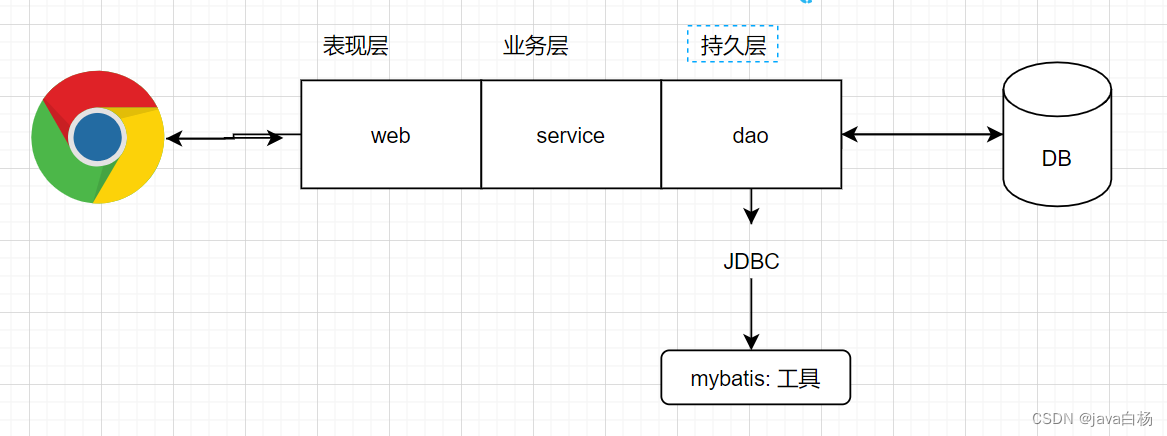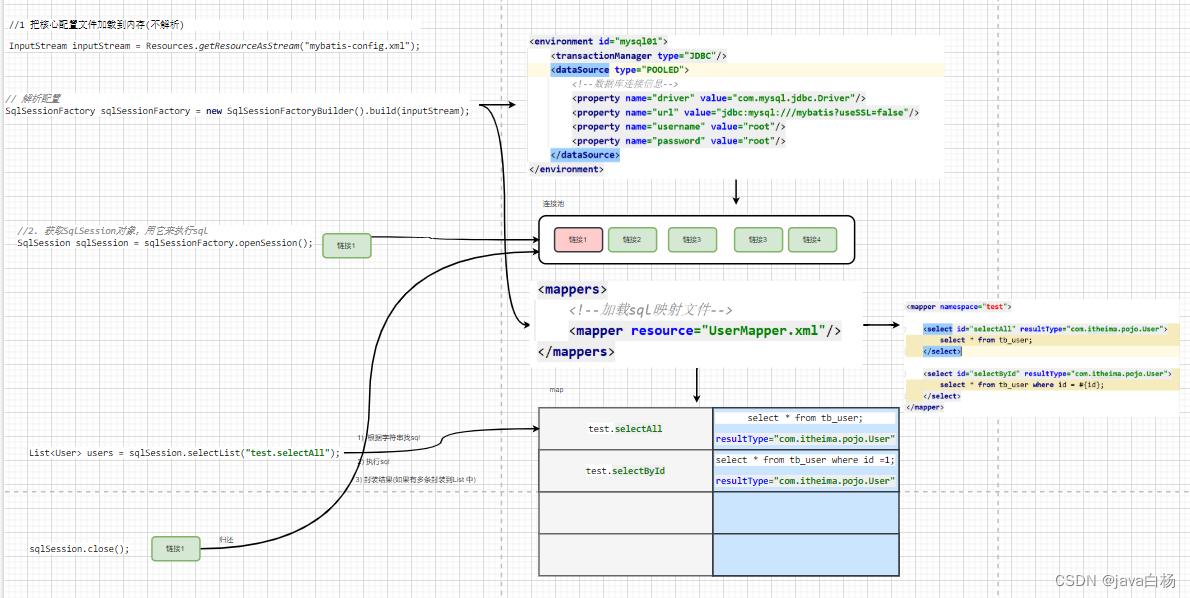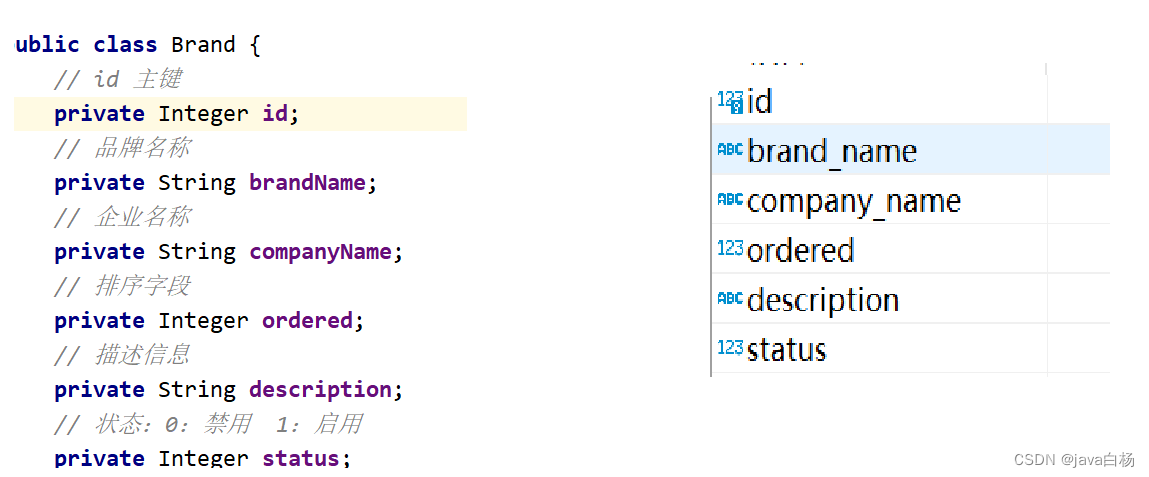Mybatis

概述
Mybatis是对jdbc 的封装,为了简化JDBc 的开发,是一个工具(框架)
框架
工具(一堆工具的合集)\半成品软件
官网
三层架构

Mybatis入门
-
数据库准备
-
新建项目(模块)
-
导入坐标
-
logback.xml
编码:
-
配置文件
mybatis-config.xml
UserMapper.xml
-
代码
实体类
编写代码查询
pom.xml
<properties>
<maven.compiler.source>8</maven.compiler.source>
<maven.compiler.target>8</maven.compiler.target>
</properties>
<dependencies>
<!--mybatis 依赖-->
<dependency>
<groupId>org.mybatis</groupId>
<artifactId>mybatis</artifactId>
<version>3.5.5</version>
</dependency>
<!--mysql 驱动-->
<dependency>
<groupId>mysql</groupId>
<artifactId>mysql-connector-java</artifactId>
<version>5.1.46</version>
<scope>runtime</scope>
</dependency>
<!--junit 单元测试-->
<dependency>
<groupId>junit</groupId>
<artifactId>junit</artifactId>
<version>4.13</version>
<scope>test</scope>
</dependency>
<!-- 添加slf4j日志api -->
<dependency>
<groupId>org.slf4j</groupId>
<artifactId>slf4j-api</artifactId>
<version>1.7.20</version>
</dependency>
<!-- 添加logback-classic依赖 -->
<dependency>
<groupId>ch.qos.logback</groupId>
<artifactId>logback-classic</artifactId>
<version>1.2.3</version>
</dependency>
<!-- 添加logback-core依赖 -->
<dependency>
<groupId>ch.qos.logback</groupId>
<artifactId>logback-core</artifactId>
<version>1.2.3</version>
</dependency>
</dependencies>
mybatis-config.xml
<?xml version="1.0" encoding="UTF-8" ?>
<!DOCTYPE configuration
PUBLIC "-//mybatis.org//DTD Config 3.0//EN"
"http://mybatis.org/dtd/mybatis-3-config.dtd">
<configuration>
<!--
environments:配置数据库连接环境信息。可以配置多个environment,通过default属性切换不同的environment
-->
<environments default="development">
<environment id="development">
<transactionManager type="JDBC"/>
<dataSource type="POOLED">
<!--数据库连接信息-->
<property name="driver" value="com.mysql.jdbc.Driver"/>
<property name="url" value="jdbc:mysql:///mybatis?useSSL=false"/>
<property name="username" value="root"/>
<property name="password" value="root"/>
</dataSource>
</environment>
</environments>
<mappers>
<!--加载sql映射文件-->
<mapper resource="UserMapper.xml"/>
</mappers>
</configuration>
UserMapper.xml
<?xml version="1.0" encoding="UTF-8" ?>
<!DOCTYPE mapper
PUBLIC "-//mybatis.org//DTD Mapper 3.0//EN"
"http://mybatis.org/dtd/mybatis-3-mapper.dtd">
<!--
namespace:名称空间
-->
<mapper namespace="test">
<select id="selectAll" resultType="com.itheima.pojo.User">
select * from tb_user;
</select>
<select id="selectById" resultType="com.itheima.pojo.User">
select * from tb_user where id = #{id};
</select>
</mapper>
Mybatis入门步骤
public static void main(String[] args) throws IOException {
//1. 加载mybatis的核心配置文件,获取 SqlSessionFactory
String resource = "mybatis-config.xml";
InputStream inputStream = Resources.getResourceAsStream(resource);
SqlSessionFactory sqlSessionFactory = new SqlSessionFactoryBuilder().build(inputStream);
//2. 获取SqlSession对象,用它来执行sql
SqlSession sqlSession = sqlSessionFactory.openSession();
//3. 执行sql
List<User> users = sqlSession.selectList("test.selectAll");
System.out.println(users);
//4. 释放资源
sqlSession.close();
}
Mybatis原理

接口开发
XXXXMapper.xml 注意事项
-
Mapper.xml 的 namespace 必须和接口的名称保持一致
-
Mapper.xml 的id 必须和 接口的方法名称保持一致
-
返回值resultType=“com.itheima.pojo.User” 必须和返回值类型一致(泛型类型一致)
-
请求参数类型必须课方法参数一致
-
为了方便加载: 配置文件名和接口的名称一致,并且编译后在同一个文件夹
<mappers> <!--Mapper代理方式--> <package name="com.xxx.mapper"/> </mappers> -
接口中的方法不允许重载
注意
在resources 文件夹创建 多级文件夹问题: 必须用斜杠 : 例如 com\xxx\mapper
核心配置文件
-
起别名
默认 TypeAliasRegistry 有别名
-
可以使用 typeAliases 自定义别名(不区分大小写)
-
environments 配置数据库链接
-
mappers 加载 xml 映射文件
插件 MybatisX
帮助开发

Lombok 插件
简化实体类的Get,Set,toString…方法
<dependency>
<groupId>org.projectlombok</groupId>
<artifactId>lombok</artifactId>
<version>1.18.20</version>
</dependency>

@Data // set,get,tostring
@AllArgsConstructor // 全参数构造
@NoArgsConstructor // 无参数构造
XXXMapper.xml
sql 片段
方便代码的编写,重复的sql 语句 (片段)只写一次即可
<!-- 抽取 -->
<sql id="sql2">
id,bbrand_name,company_name,ordered
</sql>
<!-- 使用 -->
<select id="selectAll" resultMap="brandResultMap" >
select <include refid="sql2"/> from tb_brand;
</select>
<insert id="insert" >
insert into tb_brand (<include refid="sql2"/>) values (.....)
</insert>
字段不一致问题
java 实体类属性和数据库字段名称不一致

解决方法1
起别名
<select id="selectAll" resultMap="brandResultMap" >
select id, brand_name as brandName, company_name as companyName, ordered, description, status from tb_brand
</select>
缺点
可读性差,可维护性差
解决方案2
使用resultMap
<resultMap id="map1" type="com.itheima.pojo.Brand">
<id property="id" column="id" ></id>
<result property="brandName" column="brand_anme"></result>
<result property="companyName" column="company_name"></result>
<result property="ordered" column="ordered"></result>
<result property="description" column="description"></result>
<result property="status" column="status"></result>
</resultMap>
<select id="selectAll" resultMap="map1" >
select * from tb_brand
</select>

特殊字符处理
< < 小于
> > 大于
<![CDATA[
xxxx
]]>
占位符#{},${} 区别
<select id="selectById1" resultMap="brandResultMap">
select *
from tb_brand where id = #{id};
</select>
#{}
执行SQL时,会将 #{} 占位符替换为?,将来自动设置参数值。底层使用的是 PreparedStatement (开启预编译后效率高)
${}
拼接SQL。底层使用的是 Statement,会存在SQL注入问题。
参数问题
- 当参数有一个时 #{任意}
- 当传递多个参数时
当参数是一个对象时 #{必须和参数对象的属性名保持一致}
当参数是一个map 集合时 #{必须和map 的key 保持一致}
传递多个参数使用@Param 注解
public Brand selectById4(@Param(“id”) int id,@Param(“brandName”) String brandName);
动态sql
:判断中的key 写法 和 #{} 一样
自动删除第一个无效的 连接符号,但是不会增加
单条件查询
<select id="selectByCondition1" resultMap="brandResultMap">
select *
from tb_brand
/* where 1 = 1*/
<where>
<if test="status != null">
and status = #{status}
</if>
<if test="companyName != null and companyName != '' ">
and company_name like #{companyName}
</if>
<if test="brandName != null and brandName != '' ">
and brand_name like #{brandName}
</if>
</where>
</select>
<select id="selectByConditionSingle" resultMap="brandResultMap">
select *
from tb_brand
<where>
<choose><!--相当于switch-->
<when test="status != null"><!--相当于case-->
status = #{status}
</when>
<when test="companyName != null and companyName != '' "><!--相当于case-->
company_name like #{companyName}
</when>
<when test="brandName != null and brandName != ''"><!--相当于case-->
brand_name like #{brandName}
</when>
</choose>
</where>
</select>
insert
<!-- 返回主键-->
<insert id="insert" useGeneratedKeys="true" keyProperty="id" >
insert into tb_brand (id,brand_name) values (#{id},#{brandName})
</insert>
useGeneratedKeys
是否返回主键,默认为flase,只针对insert语句生效;
keyProperty
实体类的属性,返回的名称;
update
<update id="update" >
update tb_brand
<set>
<if test="companyName!=null">
company_name=#{companyName} ,
</if>
<if test="brandName!=null">
brand_name=#{brandName},
</if>
</set>
where id =#{id}
</update>
set
去除最后一个无效的“,”号
delete
<delete id="delete">
delete from tb_brand where id in
<foreach collection="ids" item="id" open="(" separator="," close=")">
#{id}
</foreach>
</delete>
foreach
循环遍历
collection
循环遍历谁
item
循环便利的名称
open
遍历前加什么
separator
遍历每个数据加什么
close
遍历最后加什么
参数原理
POJO类型
Map集合 直接使用
其他类型
都会用map 封装,map 的key 建议使用 @Param注解 指定
MyBatis 参数封装
* 单个参数:
1. POJO类型:直接使用,属性名 和 参数占位符名称 一致
2. Map集合:直接使用,键名 和 参数占位符名称 一致
3. Collection:封装为Map集合,可以使用@Param注解,替换Map集合中默认的arg键名
map.put("arg0",collection集合);
map.put("collection",collection集合);
4. List:封装为Map集合,可以使用@Param注解,替换Map集合中默认的arg键名
map.put("arg0",list集合);
map.put("collection",list集合);
map.put("list",list集合);
5. Array:封装为Map集合,可以使用@Param注解,替换Map集合中默认的arg键名
map.put("arg0",数组);
map.put("array",数组);
6. 其他类型:直接使用
* 多个参数:封装为Map集合,可以使用@Param注解,替换Map集合中默认的arg键名
map.put("arg0",参数值1)
map.put("param1",参数值1)
map.put("param2",参数值2)
map.put("agr1",参数值2)
---------------@Param("username")
map.put("username",参数值1)
map.put("param1",参数值1)
map.put("param2",参数值2)
map.put("agr1",参数值2)
注解开发
-
@Select(“select * from tb_brand”)
@ResultMap(“brandMap”)
-
@Insert
-
@Update
-
@Delete
同一个方法不允许使用注解和xml 都存在
简单的sql 采用注解,复杂的建议使用 xml






















 2722
2722











 被折叠的 条评论
为什么被折叠?
被折叠的 条评论
为什么被折叠?










